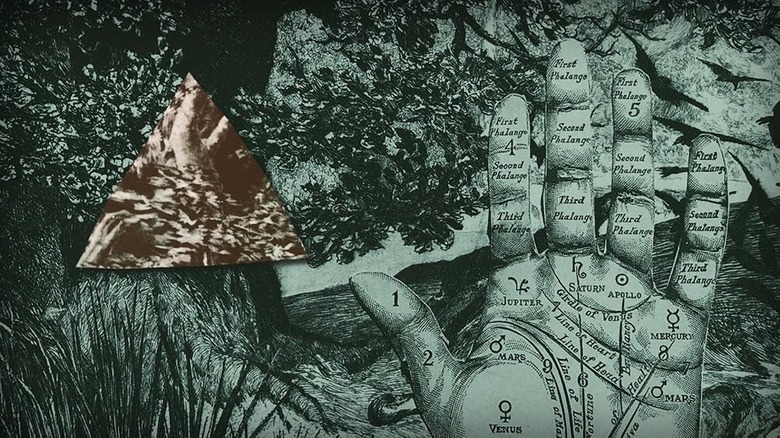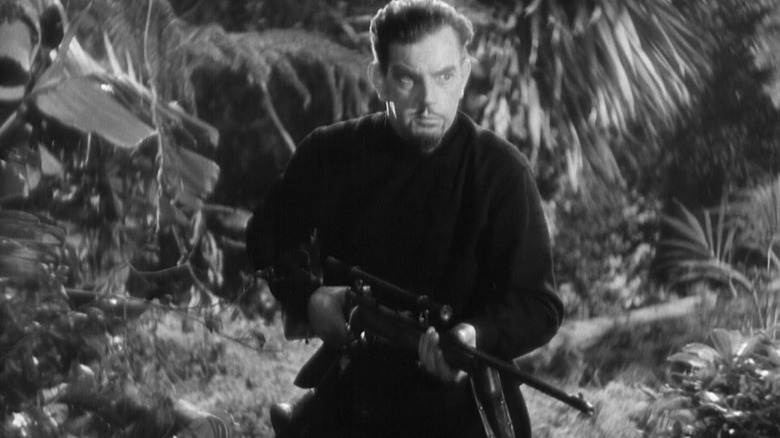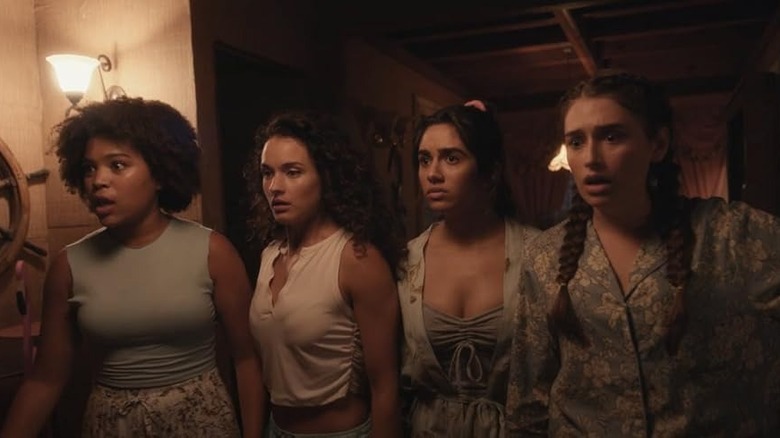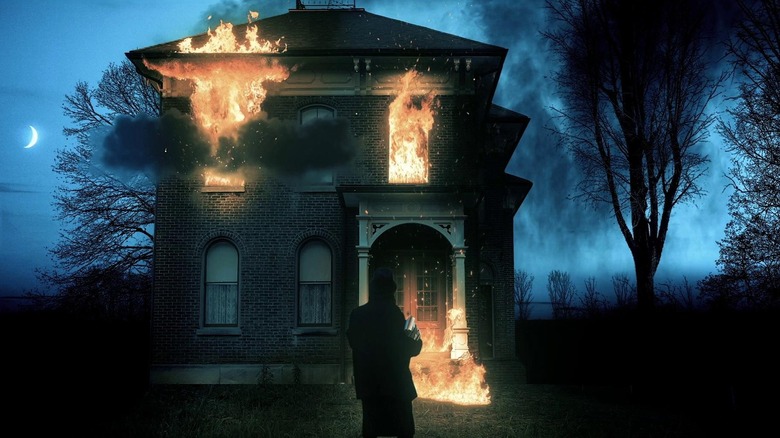There Are Only Nine Perfect Horror Movies, According To Rotten Tomatoes
There is no such thing as a perfect movie.
No matter how integral a certain film may be to the history of cinema, no matter how widely beloved it might be by a mass audience, and no matter how politically and sociologically relevant it may have been to the modern world, there is always an error, a nitpick, an omission, or a production problem that can be included. No work of art is going to be 100% unassailable, largely because a wide swath of humanity will be able to see it, and no two people are going to feel exactly the same way about it.
In modern parlance, the closest critics and audiences may be able to come to a measurable consensus is the approval rating on Rotten Tomatoes. The way Rotten Tomatoes works: professional critics, writing for a broad gallery of approved outlets, submit a review to RT, selecting it to be "fresh" or "rotten." The critic gets to select which side of that binary they fall. If 60% of critics submit "positive" reviews, then the film is deemed "fresh." 59% or less, and the film is "rotten."
Fans are also welcome to create RT accounts and log in to deem a film "fresh" or "rotten." Those votes are tallied on the "Popcornometer." Those scores aren't significant, though, as they are frequently subjected to review bombing, something the site is trying to curb with its "Verified Hot" ratings.
By that gauge, there are currently only nine horror (or horror-related) films on Rotten Tomatoes that have an enviable 100% approval rating. Some have only a few reviews, some have many, but all of them are positive. By Rotten Tomatoes' own metrics, however, these movies are better than some of the most notable horror classics in cinema history.
One Cut of the Dead (2017)
To wit: the nine films included here have all outstripped notable horror classics like "Bride of Frankenstein" (98%), "Get Out" (98%), "Jaws" (97%), "Nosferatu" (97%), "Psycho" (97%), and even John Carpenter's original "Halloween" (96%). They are also better reviewed than other comparatively low-percentage films like "The Texas Chain Saw Massacre" (89%), "The Thing" (84%), "The Shining" (83%), "The Haunting" (82%), "Scream" (81%), and "The Exorcist" (78%).
Many might consider most of the above films to be perfect, but that's not always the case. For "The Shining," for instance, critic David Denby felt the film to be pompous and un-scary. In the case of "Bride of Frankenstein," one critic named Mike Massie, writing for a website called Gone with the Twins, criticized the film's slapstick humor, feeling it undercut the film's potential horror.
Critics were, however, 100% united on "One Cut of the Dead," a wild, three-part film about a low-budget horror production gone awry (based on 97 reviews). In it, a film crew arrives at an abandoned water filtration plant to film a zombie thriller ... in one prolonged take. A quirk of the film-within-a-film's production design, however, accidentally resurrects zombies for real. The filmmakers, feeling ambitious, decide to film their movie anyway, careful to keep the cameras rolling in order to save film stock. The second and third parts of the movie pull back additional layers of "reality," pulling further and further into overlapping meta-narratives about the making of "One Cut." It's just as much an act of media analysis as a zombie comedy.
Elisabeth Vincentelli, writing for the New York Times, felt that Ueda's film updated tired meta-narrative jokes (which were in vogue way back in the 1990s) and that it was refreshingly disgusting. Likewise, Variety, IndieWire, The Hollywood Reporter, and RogerEbert.com all praised the flick.
His House (2020)
Another film to achieve the rare status of 100% approval on Rotten Tomatoes (out of 125 reviews) is the Netflix-distributed, Dinka-language thriller "His House," a film about South Sudanese immigrants settling in England. The drama follows a single family as they wait in months-long immigration office queues ... only to be placed in a terrible, run-down house on the outskirts of London. The locals are all racist, and the central family's attempts at assimilation produce disheartening results. Then, shortly after settling, they begin seeing a shadowy, ghost-like figure lurking in their house. The family matriarch Rial (Wunmi Mosaku) becomes convinced this is an apeth, a witch-like spectre that followed them from Sudan. The ghost represents, quite clearly, the war and violence Rial physically fled, but will never be able to forget.
Noted creature actor Javier Botet played the apeth. Horror fans may know Botet for playing the titular roles in "Mama" and "Slender Man," as well as the diseased beggar in the "It" movies and Dracula in "The Last Voyage of the Demeter." Also appearing is noted British actor Matt Smith.
Justin Chang of the Los Angeles Times loved the way director Remi Weekes blended B-movie horror thrills with salient themes of the immigrant experience. Amy Nicholson called it "an absolute knockout," and Nick Allen reviewed the film from Sundance, stating "From the start, 'His House' sucks you in with having hope for this couple to find some kind of new life in this impossible system, but a growing unease about what kind of trap they might be in."
Woodlands Dark and Days Bewitched: A History of Folk Horror (2021)
Not a horror film unto itself, but a documentary about horror movies, Kier-La Janisse's "Woodlands Dark and Days Bewitched: A History of Folk Horror" premiered at the SXSW film festival in 2021, and was included in the awesome Severin Films box set "All the Haunts Be Ours: A Compendium of Folk Horror." The box includes excellent wilderness-bound horror movies like "Leptirica," "Viy," "A Field in England," "Clearcut," "Panda's Fen," and several others. It also includes a two-CD audiobook of Arthur Machen's "The White People."
"Woodlands Dark" takes audiences through the long history of horror movies that are set in the wilderness and follow the rules of long-forgotten folk traditions (a reminder that modernity stepped all over a long-lived magical world that it has endeavored to forget). If one wants a long list of film recommendations, Janisse has you covered. Janisse, it should be noted, is an author and scholar perhaps best known for her 2012 work "House of Psychotic Women: An Autobiographical Topography of Female Neurosis in Horror and Exploitation Films." She also curated several film festivals and served as head programmer for the Alamo Drafthouse throughout the early 2000s. In 2010, Janisse founded The Miskatonic Institute of Horror Studies, a film school devoted to fear. She's written about Christmas horror, Canadian horror, 1940s horror, fandom, punk rock, and Jean Rollin. She knows way more than you do about horror movies.
As such, one can accept "Woodlands Dark and Deep," which runs an exhaustive 194 minutes, as the definitive work on the subject. /Film gave it a positive review.
Creep 2 (2017)
The first "Creep" movie is about a serial killer named Joseph (mumblecore giant Mark Duplass) who claims to have a brain tumor and who hires a videographer named Aaron (director Patrick Brice) to film a message for his unborn child, just like in the 1993 film "My Life." Aaron catches wise to Joseph's creepiness, however, and the remainder of the film sees Joseph stalking and taunting Aaron from afar.
"Creep 2" has a 100% approval rating on Rotten Tomatoes (based on 29 reviews), and it continues to follow Joseph, who has now taken on the name of Aaron. "Aaron," still a serial killer, is now undergoing a midlife crisis, a comedic conceit for a horror movie. As such, he wants to change his M.O. Rather than lure a victim to record a fake life story, as he did in the first film, "Aaron" instead lures Sara (Desiree Akhavan) to his lair to film his actual life story as a serial killer. Sara goes along with it, as she doesn't believe he is actually a serial killer. At least not at first. As in the first film, the Mark Duplass character gets increasingly creepy.
Dylan Scott, writing for Vox, noted that the relationship between the Duplass and Akhavan characters is similar to that of Hannibal Lecter and Clarice Starling, and liked the conceit of a serial killer reflecting on his own life. John DeFore wrote in The Hollywood Reporter that comedic awkwardness was an excellent note for a horror movie.
"Creep 2" spawned a Shudder TV series called "The Creep Tapes," which debuted in November 2024.
Frankenstein (2015)
A modern version of "The Modern Prometheus," Bernard Rose's 2015 version of "Frankenstein" updates Mary Shelley's celebrated (and oft-adapted) novel into a contemporary framework. In Rose's take, Danny Huston plays Dr. Frankenstein and Carrie-Anne Moss plays his wife Elizabeth. Right at the beginning of the film, the pair create a creature named Adam (Xavier Samuel) with the body of an adult but the brain of a child. Through a medical mistake, however, Adam begins to mutate, developing strange growths all over his body. When Dr. Frankenstein tries to euthanize him, he flees and takes to the streets.
Several familiar "Frankenstein" scenes play themselves out in a new, modern context. Adam throws a young girl into a body of water. He befriends an old blind man, this time played by the late, great Tony Todd (the titular specter in Rose's 1992 hit "Candyman").
The new "Frankenstein" only has nine reviews on Rotten Tomatoes, but all nine critics liked it. Allison Willmore, writing for Buzzfeed News, appreciated the naturalness of the story, seeing this new version of Frankenstein's monster as a symbol for anyone who has even been shunned or marginalized by society. She wrote that Rose "just brings the narrative into the present day and allows it to resonate as one about the people who are shunted to society's outskirts and treated as less than human." Gareth Jones from Dread Central wrote that "Frankenstein" served as a reminder of how little we have progressed when it comes to helping the people we ordinarily ignore.
Rose, it seems, understood that "Frankenstein" was more of a tragedy than a horror story.
The Golem: How He Came Into the World (1920)
And we come to the silent horror classics.
Know that F.W. Murnau's "Nosferatu: A Symphony of Horror" only has a 97% approval rating on Rotten Tomatoes based on 71 reviews. The few dissenting voices on "Nosferatu" merely complain that it's not scary; a 1929 review from the New York Times declared that no one would lose sleep after seeing the famed vampire hit. One could argue, though, that any negativity toward "Nosferatu" likely springs from its reputation as one of the scariest movies ever made. It's easy to write a negative review if a film falls short of expectations as "One of the Best Ever."
Paul Wegener and Carl Boese's 1920 classic "The Golem," meanwhile, has attracted no such negativity, largely because it's not quite as widely seen as other 1920s horror classics. It has a 100% approval rating based on 32 reviews. Joshua Lowe's 1921 review stated that the film was richly visualized and that the period details were dazzling.
"The Golem: How He Came into the World," based on the 1915 novel by Gustav Meyrink, tells the medieval tale of the Golem, a large clay sculpture that is brought to life by the real-life Rabbi Leow (Albert Steinrück) as a means to protect the local Jewish community from the encroaching Holy Roman Empire. The Golem proves to be an effective bodyguard, but the spirit possessing it, Astaroth, eventually forces the Golem to turn on its creators.
"The Golem" is an excellent film to watch on Halloween, and the titular monster deserves a spot in the monster canon that includes Dracula, Frankenstein, the Wolf Man, and the Phantom of the Opera.
The Most Dangerous Game (1932)
Few stories have been cinematically riffed on more frequently than Richard Connell's 1924 short story "The Most Dangerous Game." The premise is so simple: a twisted, wealthy count, living on a remote island, has become bored with hunting big game. He now lures people to his island and hunts them instead, feeling that humans are, well, the most dangerous game. If a victim can elude the sadistic Count Zaroff for three days, they will be permitted to go free.
You've seen this premise in any number of B-movies over the years, including the 2020 Quibi adaptation with Christoph Waltz and the 2022 film version starring Tom Berenger and Judd Nelson. The premise was also used in "Hard Target," "Turkey Shoot," and the seventh "Tremors" movie. The best and most famous adaptation, however, is the 1932 version directed by Ernest B. Schoedsack and Irving Pichel. In that rendition, Leslie Banks played Count Zaroff as a van dyke-sporting weirdo and Joel McCrea played his put-upon victim. Robert Armstrong and Fay Wray also costar as a brother and sister along for the ride. Wray and Schoedsack would reunite the following year for "King Kong."
The 100% approval rating for "The Most Dangerous Game" is based on 21 reviews. Anton Bitel's review for Little White Lies points out the glorious borderline between humanity and appetite that the film so salaciously highlights. The British Film Institute listed it as one of the best action movies ever made, as "Game" certainly rides the line between the genres. Indeed, one may argue that action and horror are the same, except in one the hero faces survival, while in the other, they face death.
Slumber Party Massacre (2021)
The original 1982 version of "Slumber Party Massacre," directed by Amy Jones, only sports a 46% approval rating on Rotten Tomatoes (based on 24 reviews), so it's odd that the 2021 reboot should be at 100% (based on 19 reviews). The original is a silly but fun slasher movie about a man with a drill who breaks into a teen girl's slumber party and kills off its attendees. The survivors went on to appear in 1987's "Slumber Party Massacre II" and 1990's "Slumber Party Massacre III." The franchise stands apart from other slasher properties from the era in that each film was directed by a woman.
The reboot, directed by Danishka Esterhazy ("The Banana Splitz Movie," "Killer Body Count"), follows a character named Dana (Hannah Gonera), the teenage daughter of Trish (Schelaine Bennett), the lead character from the original "Massacre." She and several friends find themselves at a remote cabin (natch) where they find themselves being stalked by a mysterious killer (also natch). Does the killer have a mysterious connection to the killer from the original movie? It seems likely.
None of the reviews of Esterhazy's "Slumber Party" are particularly effusive, but every single one of them is positive. The Guardian's review, written by Leslie Felperin, gave the film three stars, saying that it was cleverer than one might expect. It seems that the film's gender politics are openly explored, and the violence is played for fear more than for cheap, gallows laughter. The world's many slasher fans may know about the original, but fewer might have seen the reboot. This might be a good time to go looking for it.
Where the Devil Roams (2023)
The Adams Family, not to be confused with Gomez and Morticia's dynasty, are a filmmaking clan that include John Adams, Zelda Adams, and Toby Poser. In 2021, they made a notable witch film called "Hellbender," and in 2019 they made the film "The Deeper You Dig." Horror aficionados may be familiar with these titles. However, it seems that their 2023 film, "Where the Devil Roams," was the most acclaimed of the Adams' work yet, capturing the filmmakers' penchant for naturalism (as stated by the Alliance of Women Film Journalists' website), while also telling a stylized and unusual story.
Nick Allen, on RogerEbert.com, said that the film was aggressively obtuse, "but it's stitched together mighty nicely, with a growing plot about assembling body parts. Their collective filmmaking eye is still so compellingly intentional and full of riches." The film follows a trio of traveling carnival performers (the directors) who confront a series of callow customers along their performance path. It skips around between old black-and-white footage, color footage, and silent-style film. It's all very artsy, but in an appealing way.
The review in Mashable, written by Belen Edwards, is very glowing, stating that the film "revels in its slow-burn storytelling, creeping along like decay in rotting flesh (of which there is no shortage in this film). Images with seemingly no connection, including lost children's shoes and Eve's careful dismemberment of dolls, establish the movie's growing sense of dread, but also pay off in big ways in the final act."
"Where the Devil Roams" debuted at the Fantasia Film Festival in 2023, but can only be seen now on Tubi. It's free. Get cracking.









